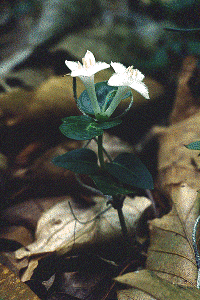
 Bright red berries call our attention to a prostrate evergreen creeping vine six inches to twelve inches long with opposite roundish leaves on short petioles. Upon close examination these berries will be found to have two "eyes". This comes from the fact that twin flowers work together to form one berry.
Bright red berries call our attention to a prostrate evergreen creeping vine six inches to twelve inches long with opposite roundish leaves on short petioles. Upon close examination these berries will be found to have two "eyes". This comes from the fact that twin flowers work together to form one berry.In late spring, two beautiful white flowers (with one calyx) each open their four petals to entice insects to collect their nectar. Each blossom has one pistil and four stamens. The pistil in one is short and the stamens are long. In the other it is just the opposite. Botanists call this "dimorphous", which means "occurring in two forms." Because of this no flower can fertilize itself--all flowers must be cross-pollinated by insects, and both flowers must be pollinated to get a single healthy berry. A berry will stay on the vine until after the blooms appear in the spring unless a hungry bird finds it nestled among the fallen winter leaves.
Partridge berry is a member of the Bedstraw or Madder Family (Rubiacea). The stems often take root at the nodes and form a mat. It transplants easily, grows quickly, but rarely becomes a pest. Try it in a shady spot, or in a terrarium.
Linnaeus named this plant Mitchella for his friend John Mitchell (a physician, naturalist, plant lover, and cartographer), who developed a method of treating yellow fever victims and saved thousands of lives; and repens because it is a trailing or creeping plant.
